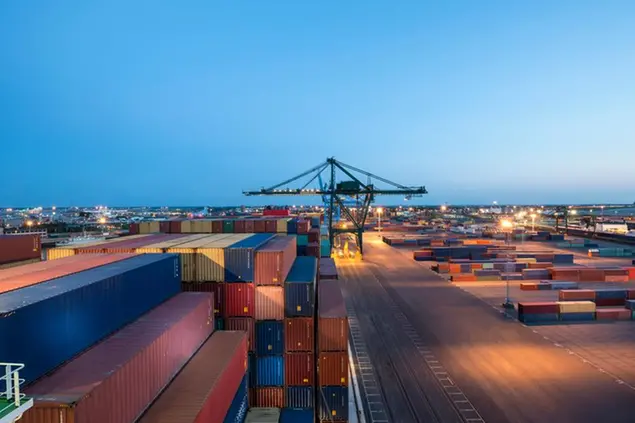PHOTO
East African Community (EAC) member states are increasingly trading with one another and with other African countries, while reduce their trade with Europe, Asia, and other parts of the world, shaping the intra-Africa trade dream projected to boost commerce and livelihoods on the continent.
The seven countries in the region (as of last year) increased their trade with the rest of Africa by $584.6 million to $4.3 billion in the fourth quarter of 2023, a 14 percent rise compared with a similar period in 2022, latest data by the EAC Secretariat shows.
Cross-border trade within the region also recorded a 12 percent rise, from the previous year’s $2.6 billion to $2.9 billion in last year’s Quarter 4, an indication of rising trade within the region over the year.
During Quarter 3, intra-EAC trade rose 20 percent to $3.2 billion, the highest level recorded within the region in over two years. Similarly, trade with the rest of Africa crossed the $5 billion mark for the first time in two years.
Read: East Africa weathers storm to record growth in FDIBut the region’s trade with the European Union (EU) countries, which traditionally account for about 10 percent of EAC’s total trade, recorded a drop of 14 percent, from $2.04 billion in the three months to December 2022, to $1.7 billion in the last quarter of 2023.
This is a signal of improving trade integration on the continent, coming at a time when governments are pushing for increased implementation of the African Continental Free Trade Area, which is projected to lift about 65 million Africans from extreme poverty.
Top EAC partners that saw a sharp decline in their dealings with the region is Belgium, whose trade dropped by 45 percent to $188 million in Quarter 4, 2023, from $263 million the previous year.
The United States, which is the tenth leading trade partner with East Africa, recorded a 19 percent drop in its business dealings with the region, from $200 million in the October-December period in 2022 to $161 million last year.
Germany, Italy, and Switzerland saw their trade with the region drop by 12 percent, 2 percent, and 23 percent respectively. The drop pushed Germany out of the rank of the 10 leading trade partners for the region.
In each of these countries, imports and exports registered a general decline, except in the case of Germany, which bought more of East African exports in the period, but sold much less of their own products in the region.
A similar trend was observed in EAC’s trade with leading Asian producers, Pakistan, Malaysia, China, Vietnam, Indonesia, and Korea.
While imports from China – the leading source for East African countries – improved, exports to the Asian powerhouse slowed by 12 percent, an indication that regional businesses are finding markets elsewhere.
Exports to Malaysia, which is the fourth leading market for East African goods, also posted a 17 percent drop in in the period, even though imports from the country rose by 47 percent.
Read: Kenya posts $1.2bn surplus in trade with AfricaAmid the decline in trade with Europe, Asia, and the US, some African countries have emerged as important trade partners for the EAC.
Trade between East Africa and the Economic Community of West African States (Ecowas), for instance, more than tripled to $199.6 million in October-December last year, from $61 million in 2022, raising its share in EAC’s total trade from 0.3 percent to 1 percent.
Similarly, trade with the Southern African Development Community (SADC) saw an improvement in the period, rising by 40 percent to 2.7 billion, improving the share in total EAC trade from 9.8 percent to 12.8 percent.
South Africa is the leading trade partner for EAC countries on the continent, with the trade between them rising by 26 percent to hit $838 million, up from $664 million in the last quarter of 2022.
John Bosco Kalisa, CEO of the East African Business Council, says improvement of EAC’s intra-Africa trade at the expense of Europe, Asia, and the US is a result of improving political will to eliminate trade barriers within the region and trade more within.“We learnt a lesson from the global shocks; Covid-19, Russia-Ukraine war, and the MidEast disruptions, which have all impacted our trade and investments,” Mr Kalisa told The EastAfrican.“One shock absorber is to build regional production capabilities, as well as at national levels, under the auspices of Buy East Africa Build East Africa initiative."Mr Kalisa, who heads the regional private sector lobby, argues that there are concerted efforts by governments in the region to promote regional value chains, and eliminate barriers to trade with one another in the region and with others across the continent.
Read: NTBs cost region $16m, threatening intra-EAC trade“That’s why now we can see there is a growth in our trade within the continent, as opposed to our trade with the EU, or China,” he said.
Previously, businesses in the region have been blamed for taking advantage of preferential trade agreements with countries outside the continent than free trade agreements within their local regional trading blocs.
A study done by the United Nations Conference on Trade and Development (UNCTAD) and the Common Market for Eastern and Southern Africa (Comesa) last year found that African countries generally take advantage of PTAs with the US, Canada, EU, and Japan, more than they utilise FTAs within their regional economic communities. © Copyright 2022 Nation Media Group. All Rights Reserved. Provided by SyndiGate Media Inc. (Syndigate.info).
